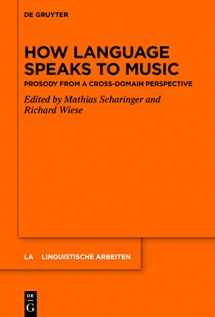
How Language Speaks to Music: Prosody from a Cross-domain Perspective (Linguistische Arbeiten, 583)
Book details
Summary
Description
Prosody as a system of suprasegmental linguistic information such as rhythm and intonation is a prime candidate for looking at the relation between language and music in a principled way. This claim is based on several aspects: First, prosody is concerned with acoustic correlates of language and music that are directly comparable with each other by their physical properties such as duration and pitch. Second, prosodic accounts suggest a hierarchical organization of prosodic units that not only resembles a syntactic hierarchy, but is viewed as (part of) an interface to syntax. Third, prosody provides a very promising ground for evolutionary accounts of language and music. Fourth, bilateral transfer effects between language and music are best illustrated on the level of prosody. Highlighting the first two aspects, this book shows that it is a fruitful endeavor to use prosody for a principled comparison of language and music. In its broader sense, prosody as sound structure of communicative systems may be considered a meta-language that formalizes the way of "how music speaks to language and vice versa". Prosody is firmly established within linguistic theory, but is also applied in the musical domain. Therefore, prosody is not just a field of inquiry that shares elements or features between music and language, but can additionally provide a common conceptual ground.
From the Back Cover
The present volume focusses on prosodic accounts of language and music and explores their overlaps and differences. It brings together interdisciplinary researchers with contributions on general mechanisms and representations underlying the prosody of language and music, the key units of prosody, the cognitive and neural networks supporting linguistic and musical prosody, clinical aspects of linguistic and musical prosody, and on transfer/interactions between the two domains, such as text-setting. The book also incorporates a wide range of methodologies, reaching from generative accounts of prosody to brain imaging techniques establishing prosodic networks.


We would LOVE it if you could help us and other readers by reviewing the book
Book review



